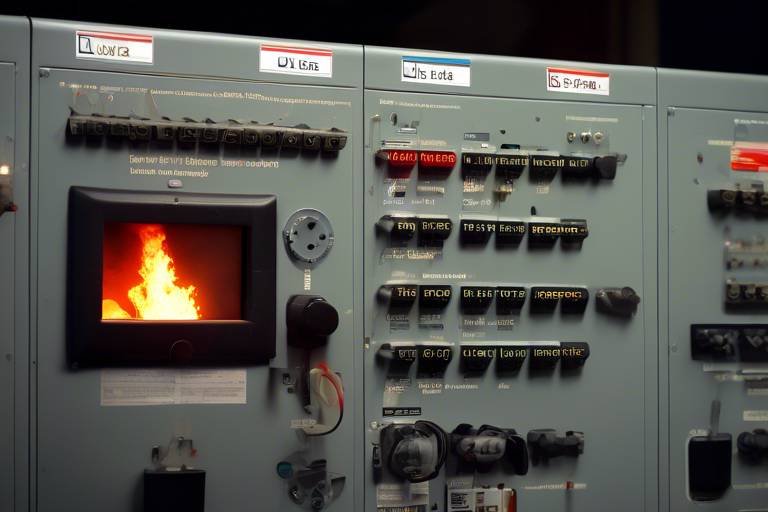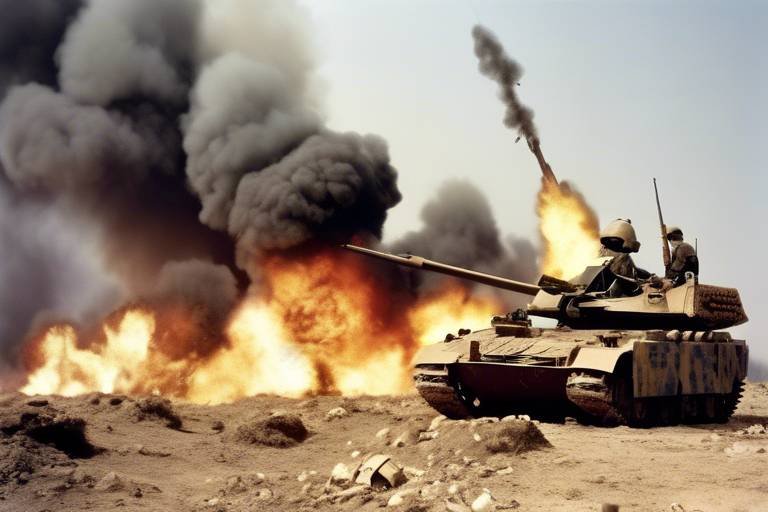The Importance of Logistics in Ammunition Supply Chains
When we think about the military and its operations, the focus often falls on the brave soldiers and advanced weaponry. However, there’s a silent hero in the background that plays a pivotal role in ensuring these operations run smoothly: logistics. The importance of logistics in ammunition supply chains cannot be overstated, as it directly impacts operational effectiveness, safety, and overall efficiency. Imagine a well-oiled machine; if one part falters, the entire operation can grind to a halt. This is especially true in the context of ammunition supply, where timely delivery can mean the difference between success and failure on the battlefield.
Logistics in ammunition supply chains involves a complex web of activities, from the production of ammunition to its storage and distribution. Each link in this chain must be meticulously managed to ensure that military units have the ammunition they need, precisely when they need it. In a world where threats can emerge unexpectedly, the ability to respond promptly is crucial. This is where the role of logistics shines, as it ensures that all components are in place for a seamless operation.
Moreover, the stakes are incredibly high. The nature of ammunition means that any mishandling or delay can not only jeopardize missions but also pose serious safety risks. Therefore, logistics managers must navigate a landscape filled with regulations, safety protocols, and operational challenges. They are tasked with ensuring that every round of ammunition is accounted for and transported safely to its destination. This requires not just a keen understanding of logistics but also a proactive approach to risk management.
In the following sections, we will delve deeper into the various components of logistics in ammunition supply chains, exploring the challenges faced, the technological advancements that are reshaping the landscape, and the critical importance of collaboration among stakeholders. By the end of this article, you will have a comprehensive understanding of why logistics is not just a support function but a vital component of military readiness and operational success.
Understanding Ammunition Supply Chains
Ammunition supply chains are the intricate networks that facilitate the production, storage, and distribution of ammunition. These chains are not merely logistical frameworks; they are the lifelines that support military readiness and operational efficiency. Imagine a well-oiled machine where every cog and gear is essential for the entire system to function smoothly. This is the essence of ammunition supply chains. Without effective logistics, the entire operation could grind to a halt, jeopardizing safety and mission success.
At the core of these supply chains lies the need for streamlined logistics. The process begins with the manufacturing of ammunition, which must be carefully coordinated with the storage facilities and distribution networks. This requires a deep understanding of various factors such as demand forecasting, production schedules, and inventory levels. For instance, if a military unit anticipates a surge in operations, logistics managers must ensure that adequate supplies are on hand, ready to be deployed at a moment's notice. This is where the synergy between different components of the supply chain becomes crucial.
Moreover, the storage of ammunition is not just about finding a place to keep it. It involves maintaining optimal conditions to prevent degradation and ensuring that the inventory is easily accessible for quick retrieval when needed. This means implementing advanced inventory management systems that track stock levels in real-time, allowing for timely replenishment and minimizing the risk of shortages. In this context, logistics becomes a balancing act, where efficiency must be weighed against safety and compliance with regulations.
The distribution phase is equally critical. It is not enough to produce and store ammunition; it must also be delivered to the right place at the right time. This involves navigating a complex landscape of transportation logistics, which can include road, rail, air, and sea transport. Each mode of transport comes with its own set of challenges, from regulatory compliance to safety concerns, making it imperative for logistics managers to develop comprehensive strategies that address these issues head-on.
In summary, understanding ammunition supply chains is about recognizing the interconnectedness of various processes that ensure operational readiness. From production to distribution, each step must be meticulously planned and executed. The stakes are high, and the consequences of mismanagement can be dire, affecting not only military operations but also the safety of personnel involved. Therefore, investing in efficient logistics is not just a good practice; it is a necessity for success in both military and commercial contexts.
Key Components of Logistics
Logistics in ammunition supply chains is a complex yet essential framework that ensures military and commercial operations run smoothly and effectively. The key components of logistics encompass various elements that work in harmony to maintain the flow of ammunition from production to the end-user. These components include transportation, warehousing, inventory management, and distribution. Each of these elements plays a critical role in ensuring that ammunition is available when and where it is needed, thereby enhancing operational readiness.
Let's dive deeper into these components. First, transportation is the lifeblood of any supply chain. It involves moving ammunition from manufacturing facilities to warehouses and ultimately to military units. This process is fraught with challenges, including the need to comply with stringent regulations and ensure the safety of the materials being transported. For instance, the transportation of ammunition must be conducted using specially designed vehicles that adhere to safety standards, preventing accidents and ensuring that the ammunition arrives intact and on time.
Next up is warehousing. Effective warehousing strategies are crucial in managing the storage of ammunition. This includes creating optimal storage conditions that minimize risks such as deterioration or accidental detonation. Advanced inventory tracking systems are employed to monitor stock levels, ensuring that military units can quickly access the ammunition they require. Imagine a well-organized library where every book is cataloged and easily retrievable; that's the level of efficiency we aim for in ammunition warehousing.
Then we have inventory management. This component is all about keeping track of what is available and what is needed. It involves sophisticated software that helps logistics managers forecast demand accurately. By analyzing historical data and current trends, they can make informed decisions about how much ammunition to produce and store. This proactive approach minimizes waste and ensures that resources are allocated effectively.
Finally, distribution ties everything together. It involves the process of delivering ammunition to various military units or commercial clients. Efficient distribution systems ensure that the right amount of ammunition reaches the right place at the right time. It’s like a well-oiled machine where each part works in sync to achieve a common goal. The logistics team must coordinate with various stakeholders, including transportation providers and military commanders, to ensure that distribution is seamless and efficient.
In summary, the key components of logistics in ammunition supply chains are not just isolated functions; they are interconnected elements that collectively enhance operational effectiveness. Understanding and optimizing these components can lead to significant improvements in efficiency, safety, and overall performance in both military and commercial contexts.
- What is the primary role of logistics in ammunition supply chains?
Logistics ensures the efficient production, storage, and distribution of ammunition, which is crucial for operational readiness. - What are the main challenges faced in transportation?
Challenges include regulatory compliance, safety concerns, and the need for secure transit methods. - How does technology impact logistics?
Advancements in technology improve accuracy, reduce costs, and enhance visibility in logistics operations. - Why is risk management important in ammunition supply chains?
Effective risk management helps address potential disruptions and ensures uninterrupted operations.
Transportation Challenges
When it comes to the transportation of ammunition, the stakes are incredibly high. We're not just talking about moving boxes from point A to point B; we're dealing with materials that can be dangerous if mishandled. This is why understanding the unique challenges of ammunition transportation is paramount for logistics managers. One of the first hurdles they face is regulatory compliance. Different countries have their own sets of rules governing the transportation of hazardous materials, including ammunition. These regulations are designed to ensure safety and security, but they can also complicate logistics operations.
Imagine trying to navigate a maze where every turn requires you to check a different set of rules. It can be overwhelming! Violating these regulations can lead to severe penalties, including hefty fines or even imprisonment, not to mention the potential for damaging the reputation of the organization involved. This is why logistics professionals must stay current with the laws in every jurisdiction where they operate.
Another significant challenge is ensuring safety during transit. The handling of ammunition requires stringent safety protocols to mitigate risks. This includes proper packaging, secure transport vehicles, and trained personnel. For example, transporting ammunition often requires specialized vehicles that can withstand impacts and prevent accidental ignition. Additionally, personnel involved in the transportation must undergo rigorous training to handle these materials safely. The logistics team must constantly assess potential risks and implement measures to minimize them.
Moreover, the need for secure transit methods cannot be overstated. The threat of theft or sabotage is a real concern, especially in conflict zones or areas with high crime rates. To combat this, logistics managers often employ advanced tracking systems and secure transport routes. The goal is to ensure that ammunition reaches its destination safely and on time, without falling into the wrong hands.
In summary, the transportation of ammunition is fraught with challenges that require careful planning and execution. From navigating complex regulations to implementing safety protocols and ensuring secure transit, logistics managers must wear many hats. The importance of effective transportation in ammunition supply chains cannot be overstated, as it directly impacts operational readiness and safety.
- What are the main challenges in ammunition transportation?
The main challenges include regulatory compliance, safety protocols, and ensuring secure transit methods.
- Why is regulatory compliance important?
Regulatory compliance is crucial because violations can lead to severe penalties and jeopardize the integrity of the supply chain.
- What safety measures are implemented during ammunition transport?
Safety measures include proper packaging, secure transport vehicles, and training for personnel involved in handling ammunition.
Regulatory Compliance
When it comes to the transportation of ammunition, is not just a box to check; it's a fundamental pillar that supports the entire logistics framework. Imagine trying to navigate a complex maze without a map—that's what logistics managers face without adherence to regulations. These rules are designed to ensure that every step, from production to delivery, meets safety and legal standards. Violations can lead to severe penalties, including hefty fines and even imprisonment, not to mention the potential for catastrophic incidents that could compromise the entire supply chain.
In many countries, the transportation of ammunition is governed by a myriad of regulations that dictate how, where, and by whom ammunition can be moved. These regulations often come from multiple sources, including federal, state, and local governments, as well as international bodies. For example, in the United States, the Department of Transportation (DOT) and the Bureau of Alcohol, Tobacco, Firearms and Explosives (ATF) set stringent guidelines that must be adhered to. Compliance with these regulations ensures that logistics operations are not only legal but also safe, reducing the risk of accidents and ensuring the security of the supply chain.
To give you a clearer picture, here's a brief overview of some critical aspects of regulatory compliance in ammunition logistics:
| Regulatory Body | Key Responsibilities |
|---|---|
| Department of Transportation (DOT) | Sets regulations for hazardous materials transportation, including packaging, labeling, and routing. |
| Bureau of Alcohol, Tobacco, Firearms and Explosives (ATF) | Regulates the production, distribution, and storage of ammunition and explosives. |
| Occupational Safety and Health Administration (OSHA) | Ensures workplace safety standards are met during the handling and transportation of ammunition. |
Moreover, compliance isn't a one-time effort; it's an ongoing commitment. Regular training and updates are essential for all personnel involved in the handling and transportation of ammunition. This includes understanding the latest regulations, proper handling techniques, and emergency response procedures. By fostering a culture of compliance, organizations not only protect themselves from legal repercussions but also contribute to the overall safety and effectiveness of military operations.
In summary, regulatory compliance in ammunition logistics is a complex but critical component that cannot be overlooked. It ensures the safety of personnel, the security of the supply chain, and the integrity of military operations. By prioritizing compliance, logistics managers can navigate the challenging landscape of ammunition transportation with confidence, ensuring that every mission is supported by a robust and reliable supply chain.
Safety Protocols
When it comes to the transportation of ammunition, are not just a set of guidelines; they are the very backbone of operational integrity. Imagine a tightly woven safety net that catches any potential mishaps before they escalate into serious incidents. The stakes are incredibly high, and a single oversight can lead to catastrophic consequences. Therefore, implementing stringent safety measures is essential for protecting both personnel and the supply chain itself.
First and foremost, training is a critical component of safety protocols. Every individual involved in the handling and transportation of ammunition must undergo rigorous training programs that cover everything from basic safety practices to emergency response procedures. This training not only equips personnel with the necessary skills but also instills a culture of safety that resonates throughout the organization. After all, a well-informed team is the first line of defense against accidents.
Moreover, regular safety audits play a crucial role in identifying vulnerabilities within the logistics process. These audits act like a health check for the supply chain, ensuring that all safety measures are up to date and effective. By conducting these evaluations periodically, organizations can uncover potential hazards and rectify them before they become problematic. It's akin to having a mechanic regularly check your car to prevent breakdowns on the road.
Another essential aspect is the use of appropriate packaging and labeling. Ammunition must be securely packaged to withstand the rigors of transportation while also being clearly labeled to communicate the inherent risks. This includes using materials that can absorb shock and prevent accidental detonation, as well as marking packages with internationally recognized hazard symbols. Such attention to detail not only enhances safety but also ensures compliance with regulatory requirements.
In addition, communication cannot be overlooked. Establishing a clear line of communication among all stakeholders—drivers, warehouse personnel, and military units—ensures that everyone is aware of their responsibilities and any potential risks involved. This collaborative approach significantly reduces the likelihood of miscommunication, which can lead to dangerous situations. It’s much like a well-rehearsed orchestra where every musician knows their part, harmonizing to create a safe and efficient operation.
Lastly, emergency response plans must be in place. These plans are like a roadmap for navigating through crises, outlining specific actions to take in the event of an incident. Whether it's a minor accident or a major emergency, having a well-defined response strategy can minimize damage and ensure swift recovery. Regular drills should be conducted to familiarize personnel with these protocols, ensuring that everyone knows exactly what to do when the unexpected occurs.
In summary, safety protocols in ammunition logistics are a multifaceted approach that encompasses training, audits, packaging, communication, and emergency planning. Each element contributes to a robust framework that not only protects lives but also ensures the integrity of the supply chain. By prioritizing safety, organizations can operate with confidence, knowing they have taken every precaution to mitigate risks and uphold their operational commitments.
- Why are safety protocols crucial in ammunition logistics? Safety protocols are essential to prevent accidents, protect personnel, and ensure the integrity of the supply chain.
- What role does training play in safety protocols? Training equips personnel with the necessary skills and knowledge to handle ammunition safely and respond effectively to emergencies.
- How often should safety audits be conducted? Regular safety audits should be conducted periodically to identify and address potential vulnerabilities in the logistics process.
- What should be included in an emergency response plan? An emergency response plan should outline specific actions to take during an incident, including evacuation procedures and communication protocols.
Warehousing and Storage Solutions
When it comes to ammunition supply chains, effective warehousing strategies are absolutely crucial. Think of a well-organized warehouse as the backbone of the entire operation—without it, everything can quickly fall apart. Ammunition must be stored under optimal conditions to ensure its reliability and safety. This means controlling factors such as temperature, humidity, and exposure to potential contaminants. If even one of these factors is neglected, the consequences could be dire, leading to failures in critical moments.
Furthermore, inventory tracking plays a pivotal role in managing ammunition supplies. In a world where every second counts, knowing exactly where each item is stored can make the difference between success and failure in military operations. Advanced inventory management systems allow logistics managers to keep tabs on stock levels, expiration dates, and even the condition of the ammunition. This level of oversight is essential for ensuring that the right munitions are available when needed, without overstocking, which can lead to unnecessary costs and waste.
Quick retrieval processes are another key aspect of warehousing. Imagine a scenario where military personnel need immediate access to ammunition during a critical operation. If the warehouse is disorganized, every second spent searching for the right supplies could mean the difference between victory and defeat. Therefore, implementing efficient retrieval systems—such as using color-coded storage or automated retrieval systems—can significantly enhance operational efficiency.
In addition to these strategies, it’s important to consider the layout of the warehouse itself. A well-planned warehouse layout can facilitate smoother operations. For instance, placing frequently used items closer to the exit can speed up the retrieval process. Similarly, ensuring that hazardous materials are stored in designated areas can prevent accidents and enhance safety for warehouse staff. Below is a simple table showcasing some essential elements of effective warehousing:
| Element | Description |
|---|---|
| Optimal Storage Conditions | Maintaining appropriate temperature and humidity levels. |
| Inventory Tracking | Utilizing systems to monitor stock levels and conditions. |
| Quick Retrieval Processes | Implementing efficient systems for accessing stored ammunition. |
| Warehouse Layout | Designing the space for maximum efficiency and safety. |
In conclusion, the importance of warehousing and storage solutions in ammunition supply chains cannot be overstated. With the right strategies in place, logistics managers can ensure that their operations run smoothly, safely, and efficiently. This not only enhances operational readiness but also contributes significantly to the overall success of military missions.
- What are the key factors to consider in ammunition storage?
Key factors include temperature control, humidity levels, and proper inventory management. - How can technology improve warehousing efficiency?
Technology, such as automated systems and data analytics, can streamline operations and reduce human error. - What safety protocols should be implemented in ammunition warehouses?
Safety protocols include proper handling procedures, regular training for personnel, and secure storage practices.
Technology in Logistics
In today’s fast-paced world, the role of technology in logistics has become a game-changer, especially in ammunition supply chains. Imagine trying to navigate a maze blindfolded; that’s what managing logistics without technology feels like. With the advent of advanced technologies, logistics managers can now see the entire landscape of their supply chains, making informed decisions that enhance efficiency and effectiveness. From automation to data analytics, these technological advancements are not just trends; they are essential tools that revolutionize how ammunition is stored, tracked, and delivered.
One of the most significant advancements is the integration of automation in warehousing. Think about how a well-oiled machine operates; it’s all about precision and speed. Automation technologies enable warehouses to function with remarkable efficiency. Automated systems can handle everything from sorting to packaging, drastically reducing the time it takes to fulfill orders. This is crucial in the ammunition supply chain, where the stakes are high, and every second counts. By minimizing human error and accelerating processes, automation ensures that military units receive their supplies on time, ready for action.
Moreover, data analytics plays a pivotal role in optimizing logistics operations. Imagine having a crystal ball that predicts future demand; that’s what data analytics does for logistics managers. By analyzing historical data and current trends, logistics teams can forecast inventory needs more accurately. This proactive approach not only helps in maintaining optimal stock levels but also prevents costly overstock situations. For instance, during peak military operations, having the right amount of ammunition readily available can mean the difference between success and failure on the battlefield.
To illustrate the impact of technology on logistics, consider the following table that highlights key technological tools and their benefits in ammunition supply chains:
| Technology | Benefits |
|---|---|
| Automation | Increases speed, reduces errors, enhances efficiency in order fulfillment. |
| Data Analytics | Improves demand forecasting, optimizes inventory levels, enhances decision-making. |
| GPS Tracking | Provides real-time location data, enhances security, ensures timely deliveries. |
| Cloud Computing | Facilitates data sharing, improves collaboration, enhances accessibility. |
In addition to automation and data analytics, technologies like GPS tracking and cloud computing are also critical in modern logistics. GPS tracking allows for real-time monitoring of shipments, ensuring that ammunition is not only delivered on time but also securely. This capability is vital in military operations where the safety of personnel and the integrity of the supply chain are paramount. Meanwhile, cloud computing enhances collaboration among stakeholders by providing a centralized platform for data sharing and communication. This fosters a more cohesive approach to logistics management, allowing for quicker responses to any challenges that may arise.
In conclusion, the integration of technology into logistics is not merely an enhancement; it is a necessity. As we continue to evolve in a world that demands speed and accuracy, the ammunition supply chain must leverage these advancements to remain effective and efficient. After all, in the realm of logistics, being ahead of the curve can make all the difference.
- What is the role of technology in logistics? Technology streamlines processes, enhances accuracy, and improves overall efficiency in logistics operations.
- How does automation benefit ammunition supply chains? Automation increases speed, reduces human error, and ensures timely order fulfillment, which is critical in military operations.
- What is data analytics used for in logistics? Data analytics helps in demand forecasting, inventory optimization, and informed decision-making.
- Why is GPS tracking important in ammunition logistics? GPS tracking provides real-time location data, ensuring timely deliveries and enhancing security.
Automation in Warehousing
In today's fast-paced world, has become a game-changer, especially in the context of ammunition supply chains. Imagine a bustling warehouse where every item is accounted for, every movement is tracked, and every order is fulfilled with lightning speed. This is not just a dream; it's the reality that automation brings to the table. By integrating automated systems, organizations can significantly enhance their operational efficiency, reduce human error, and ultimately ensure that military units receive their supplies on time.
One of the primary benefits of automation is the reduction of manual labor. Traditional warehousing relies heavily on human workers for tasks such as picking, packing, and inventory management. However, with automation, many of these tasks can be performed by machines, which not only speeds up the process but also minimizes the risk of accidents that can occur during manual handling. For example, automated guided vehicles (AGVs) can transport ammunition within the warehouse, ensuring safe and efficient movement without the need for human intervention.
Moreover, automation enhances inventory accuracy. With automated systems, the chances of misplacing or losing ammunition are drastically reduced. Each item can be tracked in real-time using advanced technologies such as RFID (Radio Frequency Identification) and barcode scanning. This level of precision is essential in the ammunition supply chain, where even a small error can lead to significant operational setbacks. Consider a scenario where a military unit is waiting for critical supplies. If the inventory is mismanaged, it could mean the difference between success and failure on the battlefield.
The implementation of automated systems also leads to faster order fulfillment. In a high-stakes environment like military operations, time is of the essence. Automated systems can process orders in a fraction of the time it would take a human worker. This efficiency is particularly crucial during peak demand periods or when unexpected situations arise, such as heightened military activity. For instance, an automated warehouse can quickly adapt to increased order volumes, ensuring that troops receive their ammunition without delay.
In addition to these benefits, automation contributes to better safety standards. Handling ammunition is inherently risky, and any measures that can reduce this risk are invaluable. Automated systems can be programmed to follow strict safety protocols, minimizing the potential for accidents. For example, automated systems can ensure that hazardous materials are stored under optimal conditions, thus reducing the risk of accidents that could endanger personnel.
While the advantages of automation are clear, it's also essential to consider the initial investment and training required for successful implementation. Organizations must weigh the costs against the long-term benefits, but many find that the return on investment justifies the expense. In fact, a well-implemented automated system can lead to a significant decrease in labor costs over time, not to mention the savings from reduced errors and faster processing times.
In conclusion, automation in warehousing is not just a trend; it's a necessity for modern ammunition supply chains. By embracing technology, organizations can improve efficiency, accuracy, and safety, ultimately ensuring that military operations run smoothly and effectively. As we move forward, it's clear that those who adapt to these technological advancements will be better positioned to meet the challenges of the future.
Data Analytics for Optimization
In the fast-paced world of ammunition supply chains, data analytics has emerged as a game-changer, providing logistics managers with the tools they need to make informed decisions. Imagine trying to navigate a complex maze without a map—this is what managing ammunition logistics would be like without the insights provided by data analytics. With the right data at their fingertips, logistics teams can optimize inventory levels, streamline operations, and enhance overall efficiency.
One of the most significant benefits of utilizing data analytics is its ability to improve demand forecasting. By analyzing historical data, market trends, and other relevant factors, logistics managers can predict future demand for ammunition more accurately. This predictive capability is crucial, as it allows organizations to adjust their production schedules and inventory levels accordingly. In turn, this reduces the risk of overstocking or stockouts, both of which can be costly and detrimental to operational readiness.
Moreover, data analytics enables organizations to identify patterns and trends that might otherwise go unnoticed. For instance, by examining shipping data, logistics teams can pinpoint recurring delays or inefficiencies in transportation routes. Armed with this information, they can implement changes to improve delivery times. In essence, data analytics acts as a magnifying glass, revealing insights that lead to enhanced performance across the supply chain.
Furthermore, the integration of real-time data into logistics operations allows for immediate adjustments based on current conditions. For example, if a natural disaster disrupts a transportation route, logistics managers can quickly analyze alternative routes and make informed decisions to reroute deliveries. This agility is essential in maintaining the integrity of the ammunition supply chain, especially in high-stakes military operations.
To illustrate the impact of data analytics on optimization, consider the following table that outlines key performance indicators (KPIs) that can be enhanced through effective data analysis:
| Key Performance Indicator | Impact of Data Analytics |
|---|---|
| Inventory Turnover Rate | Improved forecasting leads to optimal stock levels, reducing excess inventory. |
| Order Fulfillment Time | Real-time data allows for quicker adjustments, enhancing delivery speed. |
| Transportation Costs | Data-driven route optimization reduces fuel costs and improves efficiency. |
| Supply Chain Visibility | Analytics provide insights into every step of the supply chain, fostering transparency. |
In conclusion, the role of data analytics in ammunition supply chains cannot be overstated. It empowers logistics managers to make data-driven decisions that enhance operational efficiency, reduce costs, and improve overall performance. As technology continues to evolve, the integration of advanced analytics into logistics will only become more vital, ensuring that ammunition supply chains remain agile and responsive to the ever-changing demands of military and commercial operations.
- What is the role of data analytics in logistics? Data analytics helps logistics managers make informed decisions by providing insights into inventory levels, demand forecasting, and operational efficiency.
- How can data analytics improve demand forecasting? By analyzing historical data and market trends, organizations can predict future demand more accurately, allowing for better inventory management.
- What are some key performance indicators in ammunition supply chains? Key performance indicators include inventory turnover rate, order fulfillment time, transportation costs, and supply chain visibility.
- Why is real-time data important in logistics? Real-time data allows logistics teams to make immediate adjustments based on current conditions, enhancing responsiveness and operational integrity.
Risk Management Strategies
In the intricate world of ammunition supply chains, effective risk management is not just a necessity; it's a lifeline. The unpredictable nature of global events—from natural disasters to geopolitical tensions—can create significant disruptions that threaten the smooth flow of operations. Therefore, logistics managers must adopt comprehensive strategies to mitigate these risks and ensure that ammunition is available when and where it’s needed.
One of the cornerstones of risk management is contingency planning. This involves developing robust plans that outline how to respond to potential disruptions. Imagine a well-oiled machine; if one cog fails, the entire system can grind to a halt. By anticipating possible challenges and preparing responses, logistics teams can minimize downtime and maintain supply chain integrity. For instance, if a natural disaster occurs, having a contingency plan in place allows teams to quickly reroute shipments or find alternative suppliers, ensuring that military units receive their ammunition without delay.
Another critical aspect of risk management is fostering collaboration with stakeholders. This includes suppliers, military units, and regulatory bodies. When all parties are on the same page, communication flows more smoothly, and coordination becomes seamless. For example, regular meetings with suppliers can provide insights into potential supply shortages, allowing logistics managers to adjust their strategies proactively. Additionally, maintaining strong relationships with regulatory bodies ensures that logistics operations remain compliant, reducing the risk of penalties that could disrupt the supply chain.
To illustrate the importance of these strategies, consider the following table that highlights key risk factors and corresponding management strategies:
| Risk Factor | Management Strategy |
|---|---|
| Natural Disasters | Develop contingency plans and establish alternative supply routes. |
| Geopolitical Tensions | Strengthen relationships with local suppliers and diversify sourcing. |
| Supply Shortages | Implement inventory tracking systems and maintain safety stock levels. |
| Regulatory Changes | Regularly review compliance requirements and maintain open communication with regulators. |
Moreover, logistics managers should embrace technology as a vital tool for risk management. Advanced software solutions can provide real-time data on inventory levels and supply chain status, enabling quicker decision-making in response to disruptions. The use of predictive analytics can also help forecast potential risks, allowing teams to prepare in advance. Think of it as having a crystal ball that reveals not just the current state of affairs but also potential future challenges.
In conclusion, the landscape of ammunition supply chains is fraught with challenges, but with effective risk management strategies, logistics teams can navigate these turbulent waters. By focusing on contingency planning, fostering collaboration, and leveraging technology, they can ensure that operations remain uninterrupted, ultimately supporting the mission readiness of military units.
- What are the main risks in ammunition supply chains? Natural disasters, geopolitical tensions, supply shortages, and regulatory changes are among the primary risks.
- How can contingency planning help? It prepares logistics teams to respond swiftly to disruptions, minimizing downtime and ensuring supply chain integrity.
- Why is collaboration important in risk management? Collaboration enhances communication and coordination, making it easier to address potential risks effectively.
- What role does technology play in risk management? Technology provides real-time data and predictive analytics, enabling quicker and more informed decision-making.
Contingency Planning
In the unpredictable world of ammunition supply chains, is not just a best practice; it's a necessity. Imagine a military operation where supplies are delayed due to unforeseen circumstances. The consequences can be dire, affecting not just the mission but the safety of personnel involved. Therefore, having a robust contingency plan in place is akin to having a life jacket on a turbulent sea; it ensures that you remain afloat even when the waters get choppy.
Contingency planning involves anticipating potential disruptions and preparing strategies to mitigate their impacts. This can include anything from natural disasters like hurricanes and floods to geopolitical tensions that may arise suddenly. By identifying these risks ahead of time, logistics teams can create action plans that are ready to be deployed at a moment’s notice. For instance, if a key supplier is located in a region prone to earthquakes, establishing alternative suppliers and routes becomes essential in maintaining a steady flow of ammunition.
Moreover, effective contingency planning requires collaboration among various stakeholders. This means that logistics managers must work closely with suppliers, military units, and even regulatory bodies to ensure that everyone is on the same page. Regular communication can help identify potential issues before they escalate into crises. For example, if a supplier anticipates a delay due to a manufacturing issue, early notification allows the logistics team to adjust their plans accordingly, perhaps by sourcing from another supplier or increasing inventory levels in advance.
To illustrate the importance of contingency planning in ammunition supply chains, consider the following table that outlines potential risks and corresponding contingency strategies:
| Potential Risk | Contingency Strategy |
|---|---|
| Natural Disasters | Identify alternative transportation routes and suppliers in safe zones. |
| Geopolitical Tensions | Establish relationships with multiple suppliers across different regions. |
| Supply Shortages | Maintain a safety stock of critical ammunition types to buffer against shortages. |
| Regulatory Changes | Stay updated on regulations and have a compliance team ready to adapt quickly. |
In addition to these strategies, regular training and drills can significantly enhance the preparedness of logistics teams. Just as firefighters practice their response to emergencies, logistics personnel should engage in simulation exercises that mimic real-world disruptions. This not only builds confidence but also uncovers potential weaknesses in the existing plans. Remember, the goal is to minimize downtime and maintain supply chain integrity during crises.
In conclusion, contingency planning in ammunition supply chains is not merely about having a plan; it’s about creating a culture of readiness. By anticipating challenges, fostering collaboration, and continuously improving strategies, logistics teams can ensure that they are not just surviving disruptions but thriving despite them. After all, in the world of logistics, the only constant is change, and being prepared is the best way to navigate it.
- What is contingency planning in logistics? Contingency planning in logistics refers to the process of preparing for unexpected disruptions by developing strategies to mitigate risks and ensure continuity of operations.
- Why is contingency planning important in ammunition supply chains? It is crucial because it helps to maintain operational readiness and safety during unforeseen events, ensuring that military units receive the supplies they need without delay.
- How can organizations improve their contingency planning? Organizations can improve their contingency planning by conducting regular risk assessments, engaging in stakeholder collaboration, and practicing emergency response drills.
Collaboration with Stakeholders
In the realm of ammunition supply chains, is not just a buzzword; it's a fundamental strategy that can make or break operational success. Imagine trying to build a house without a solid foundation—this is what a supply chain looks like without effective collaboration. Stakeholders, including suppliers, military units, regulatory bodies, and logistics providers, play distinct yet interconnected roles that are crucial for ensuring a seamless flow of ammunition from production to the front lines.
One of the primary benefits of fostering strong relationships with these stakeholders is the enhanced communication it brings. When all parties are aligned and sharing information, the chances of miscommunication are drastically reduced. For instance, if a military unit knows exactly when to expect a shipment, they can prepare accordingly, ensuring that their operations run smoothly. This kind of proactive communication can save time, resources, and even lives in high-stakes situations.
Moreover, collaboration helps in risk management. By working closely with suppliers and regulatory bodies, logistics managers can anticipate potential disruptions and develop strategies to mitigate them. For example, if a supplier is facing a delay due to unforeseen circumstances, early communication allows the logistics team to adjust their plans, perhaps by sourcing from an alternative supplier or reallocating existing inventory. In this way, collaboration acts like a safety net, catching potential issues before they escalate into crises.
Another critical aspect of collaboration is the ability to leverage shared resources. When stakeholders pool their resources, it can lead to significant cost savings and improved efficiency. For instance, by sharing warehousing facilities, multiple stakeholders can reduce overhead costs and improve inventory turnover rates. This collaborative approach not only enhances operational effectiveness but also fosters a sense of community among stakeholders, which can be invaluable in times of crisis.
Furthermore, the integration of technology into these collaborative efforts can take communication and efficiency to the next level. Tools like real-time tracking systems and collaborative software platforms allow stakeholders to stay connected and informed at all times. This technological backbone ensures that everyone is on the same page, facilitating quicker decision-making and more agile responses to changing circumstances.
To sum up, collaboration with stakeholders is a vital component of effective logistics in ammunition supply chains. By enhancing communication, improving risk management, sharing resources, and leveraging technology, stakeholders can work together to create a more resilient and efficient supply chain. In a world where every second counts, this collaborative spirit can mean the difference between success and failure.
- Why is collaboration important in ammunition supply chains? Collaboration enhances communication, improves risk management, and allows for shared resources, which can lead to more efficient operations.
- How can technology aid collaboration among stakeholders? Technology such as real-time tracking systems and collaborative software can keep all stakeholders informed and connected, facilitating quicker decision-making.
- What are the risks of not collaborating with stakeholders? A lack of collaboration can lead to miscommunication, delays, and increased operational risks, ultimately jeopardizing the supply chain's integrity.
Frequently Asked Questions
- What is the role of logistics in ammunition supply chains?
Logistics plays a critical role in ammunition supply chains by ensuring the efficient production, storage, and distribution of ammunition. It helps maintain operational readiness and timely delivery to military units, which is essential for both military and commercial operations.
- What are the key components of logistics in ammunition supply chains?
The key components include transportation, warehousing, inventory management, and distribution. Each of these components is vital for maintaining efficiency and meeting the demands of military operations, ensuring that ammunition is available when and where it is needed.
- What transportation challenges do ammunition supply chains face?
Ammunition transportation faces unique challenges such as regulatory compliance, safety concerns, and the need for secure transit methods. These challenges are crucial to preventing accidents and ensuring timely delivery to military units.
- How important is regulatory compliance in ammunition logistics?
Regulatory compliance is extremely important in ammunition logistics. Violations can lead to severe penalties and jeopardize the integrity of the supply chain, making it essential for logistics managers to adhere to all relevant regulations.
- What safety protocols should be implemented during ammunition transportation?
Implementing stringent safety protocols is vital to minimize risks associated with ammunition handling. This ensures the safety of personnel and the security of the supply chain, protecting both the workforce and the materials being transported.
- How does technology impact logistics in ammunition supply chains?
Technology significantly transforms logistics by introducing automation and data analytics. These advancements improve accuracy, reduce costs, and enhance overall supply chain visibility, making operations more efficient.
- What role does automation play in warehousing for ammunition?
Automation in warehousing streamlines operations, enabling faster order fulfillment and reducing human error. This is particularly crucial for managing large volumes of ammunition, ensuring that inventory is processed quickly and accurately.
- How can data analytics optimize ammunition supply chains?
Data analytics allows logistics managers to make informed decisions by optimizing inventory levels and improving demand forecasting. This leads to more efficient supply chain operations and better preparedness for fluctuations in demand.
- What are effective risk management strategies in ammunition supply chains?
Effective risk management strategies include developing robust contingency plans and collaborating with stakeholders. These strategies help address potential disruptions, ensuring uninterrupted operations during crises.
- Why is collaboration with stakeholders important in logistics?
Collaboration with suppliers, military units, and regulatory bodies enhances risk management efforts. It fosters communication and coordination, which are essential for creating a resilient ammunition supply chain that can withstand various challenges.



















